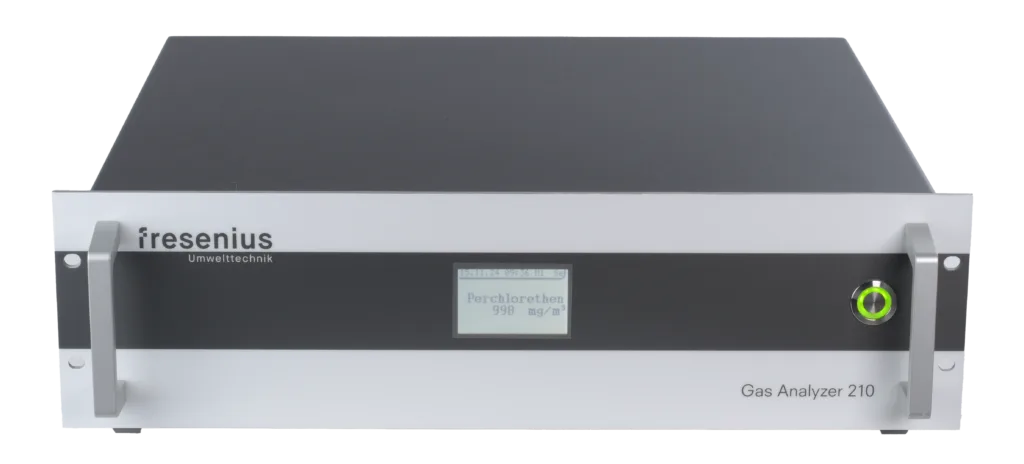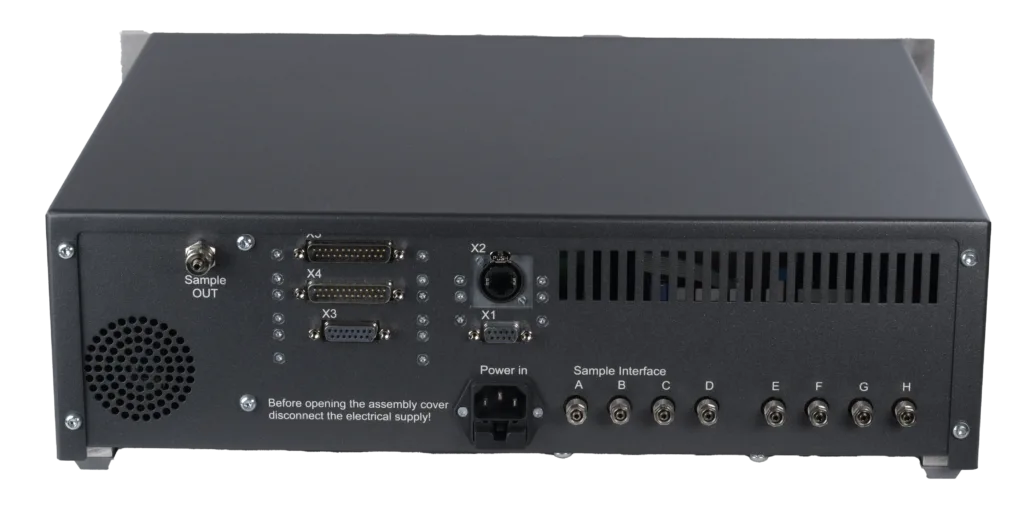
Front view

Back
Gas Analyzer 210
Maximum precision, minimum maintenance: The Gas Analyzer 210 provides reliable and continuous measurements for demanding industrial processes where, for example, perchloroethene, trichloroethene, dichloromethane or KWL need to be measured. With the option of using NDIR, zirconium oxide or an electrochemical sensor, it is the perfect solution for your complex requirements.
The Gas Analyzer 210 is your versatile partner for the precise monitoring of process gases in a wide range of industrial environments. The GA210 comes with different alternatives of measuring principles: NDIR measuring cells, zirconium oxide sensors and electrochemical sensors are available. This allows the GA210 to precisely fulfill specific measurement requirements.
Whether for process control, environmental compliance or safety monitoring, the Gas Analyzer 210 offers you maximum measurement accuracy and stability. It is the ideal choice for industries where reliability and long-term stability are crucial, such as the chemical, pharmaceutical, recycling and energy industries.
- Precise measurement technology: The Gas Analyzer 210 uses NDIR for IR-active gases such as perchloroethene, trichloroethene, dichloromethane or KWL. Alternatively, it uses an EC (e.g. O₂, H₂S, H₂) or ZrO₂ sensor (O₂).
- Long-term stability: Long-life sensors guarantee high accuracy, minimal drift and reduced calibration effort.
- Ease of use: Intuitive 128 x 64 touch display for clear measured values and simple menu navigation in plain text.
- Low maintenance costs: Robust design and reliable sensors reduce maintenance and operating costs.
- Flexible interface options: RS232, Profibus DP, Ethernet IP, Modbus TCP, Profinet. Up to eight analog outputs (4 - 20 mA) possible.
- Expandable inputs: Up to eight sample gas inputs for analyzing multiple sample locations, even for single component measurement.
- Industrial design: Robust 19-inch housing (IP20) for industrial environments.
- Optimized gas routing: PTFE or stainless steel gas routing minimizes contamination and ensures consistent measurement results.
The Gas Analyzer 210 is used in a wide range of industries where accuracy, reliability and robust measurement technology are required:
- Chemical industry: For monitoring process gases and ensuring consistent product quality.
- Recycling and waste management: Control of emissions in recycling processes to minimize environmental impact and risks to employees.
- Pharmaceutical industry: Precise gas measurement to meet the high purity and safety standards in pharmaceutical production processes.
- Power plants and energy systems: Optimization of combustion processes and monitoring of emissions to maximize energy efficiency.
- Exhaust gas monitoring and environmental protection: Ensuring compliance with legal requirements for air quality and emissions in various branches of industry.
- Sample gas inputs: 1 (standard), expandable up to 8
- Measurement interval: 1 second (continuous) or 20 seconds (quasi-continuous)
- Measurement principle: NDIR single-beam method, electrochemical method (EC), zirconium oxide ion conductor principle (ZrO₂)
- Measurable gas components:
- NDIR: perchloroethene, R11, R12, C-pentane and many other IR-active substances
- EC: including oxygen (O₂), hydrogen sulphide (H₂S), hydrogen (H₂)
- ZrO₂: Oxygen (O₂)
- Measuring range: 100 % by volume / 0-10,000 ppm depending on substance
- Measuring accuracy: Dependent on substance
- Gas flow rate: standard 4 l/min, internal gas routing made of PTFE (optionally stainless steel)
- Pressure tolerance: 0.7 to 1.1 bar (process gas pressure)
- Protection class: IP 20
- Interfaces: RS232, Profibus DP, Ethernet Modbus TCP, Ethernet IP, Profinet, up to 8 analog outputs (gal. Isolated) 4-20 mA, freely configurable via display menu
- Operational readiness: Measurement readiness dependent on substance, full specification achieved after 30 minutes
- Operating voltage: Standard: 230 V AC / 50 Hz, 0.9 A / 207 VA
Alternative: 115 V AC / 60 Hz or 230 V / 60 Hz - Dimensions: 19" rack, 400 mm depth
- Weight: 13 kg
Advantages
Maximum flexibility with the measurement parameters
The Gas Analyzer 210 was developed to adapt perfectly to the requirements of your industrial environment. With the ability to integrate up to eight sample gas inputs, you can flexibly monitor and analyze different sample locations. The Gas Analyzer 210 was designed as a single-gas measuring device and specializes in a single gas component. The measurement method can be selected on a modular basis(NDIR, zirconium oxide or electrochemical sensor technology).

Minimal calibration effort and low service costs
With the Gas Analyzer 210, you reduce operating costs through low calibration effort and minimal maintenance requirements. The device is designed to work reliably over long periods of time without the need for frequent calibrations. You also benefit from low service costs and high availability.

FAQ
For which gases can the Gas Analyzer 210 be used?
The Gas Analyzer 210 is optimized for the measurement of IR-active gases such as perchloroethene, trichloroethene and dichloromethane or KWL.
Instead, it can also be equipped with an electrochemical sensor for gases such as oxygen, hydrogen sulphide and hydrogen.
Another alternative would be the zirconium oxide sensor. This enables precise oxygen measurements.
Other substances can be integrated on request for special requirements. Simply get in touch with us.
How many measuring points can the Gas Analyzer 210 monitor?
Thanks to its flexible connection options, the Gas Analyzer 210 can be expanded to up to eight measuring points and thus analyze different gas samples.
Which measurement technologies can be selected for the Gas Analyzer 210?
Various measurement technologies can be selected for the Gas Analyzer 210: The NDIR method (non-dispersive infrared), the electrochemical method (EC) or zirconium oxide technology(ZrO₂) for oxygen measurements.
The NDIR method can be selected for the measurement of IR-active gases. The method is precise and stable over the long term. Thanks to the ZeroLock automatic zero point correction and cross-sensitivity compensation, it is virtually maintenance-free and very economical to operate.
EC sensors can be selected for measuring oxygen (O₂), hydrogen sulphide (H₂S), hydrogen (H₂), for example, if the environment is controlled, the costs must be low and the oxygen concentration is measured in small quantities.
Zirconium oxide sensors should be selected for oxygen measurement in industrial applications where high temperatures or humidity prevail in the gas to be measured or when a longer service life of the measuring cell (compared to EC sensors) is required.
Other substances can be integrated on request for special requirements.
What advantages does the Gas Analyzer 210 offer in terms of maintenance and calibration?
Thanks to the robust and long-term stable sensors, the Gas Analyzer 210 requires only minimal calibration. The long-lasting components significantly reduce maintenance costs and thus ensure low operating costs and high system availability. Our service team will be happy to carry out regular maintenance for you.
How long does it take until the Gas Analyzer 210 is ready for operation?
The Gas Analyzer 210 reaches its full specification after a warm-up time of around 30 minutes. Measurement readiness is achieved earlier, allowing you to commission the device quickly.
What communication interfaces does the Gas Analyzer 210 offer?
The Gas Analyzer 210 is equipped with an RS232 interface as standard. Profibus DP, Ethernet Modbus TCP, Ethernet IP and Profinet can be added as options. In addition, up to eight analog outputs (4-20 mA) can be configured for easy integration into existing process control systems.
Why does the Gas Analyzer 210 make economic sense for our production processes?
The Gas Analyzer 210 does far more than just monitor gas concentrations. It enables better control and optimization of process conditions, which leads directly to increased efficiency and product quality. As the Gas Analyzer detects deviations at an early stage, processes can be adjusted immediately. This minimizes rejects and faulty batches and ensures that fewer resources - be it material, energy or manpower - are wasted. Ultimately, this reduces production costs and increases the yield per production run.
How does the Gas Analyzer 210 support compliance with legal requirements and safety in our production processes?
With its precise real-time monitoring of critical gases such as O₂, H₂S or KWL, the Gas Analyzer 210 contributes to compliance with legal limits and the avoidance of safety risks. Our measurement technology provides reliable data for legally required emission reports and warns of toxic or explosive gas concentrations. Immediate alarms (via relay outputs) detect and report dangerous concentrations. The open interface architecture (e.g. Profibus, Ethernet/IP) also enables seamless integration into safety systems to trigger automatic emergency shutdowns or valve controls - crucial for compliance with operational safety and environmental protection regulations.
How can the Gas Analyzer 210 make a concrete contribution to reducing costs?
In addition to the low maintenance requirements, the Gas Analyzer 210 helps to avoid unnecessary costs in production thanks to its precise and stable measured values. By precisely monitoring process gases, companies can achieve targeted energy savings by optimally controlling combustion or chemical reactions. Continuous monitoring also reduces the risk of system malfunctions, which often lead to expensive production downtimes. Fewer interruptions mean lower costs and higher productivity.
Interested?
Contact us for comprehensive advice - holistic and solution-oriented.

Fresenius Umwelttechnik GmbH
Office hours
Time zone CEST
The company
Contact us
© 2024 Fresenius Umwelttechnik GmbH

